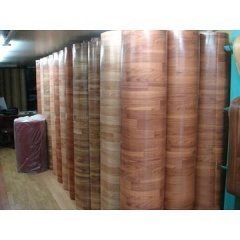Floorings
| Infobox on Floorings | |
|---|---|
| Example of Floorings |  |
| Facts | |
| Origin | - |
| Stowage factor (in m3/t) | - |
| Humidity / moisture | - |
| Ventilation | - |
| Risk factors | See text |
Floorings
Description / Application
Flooring is the general term for a permanent covering of a floor, or for the work of installing such a floor covering. Floor covering is a term to generically describe any finish material applied over a floor structure to provide a walking surface. Both terms are used interchangeably but floor covering refers more to loose-laid materials.
Materials almost always classified as floor covering include carpet, area rugs, and resilient flooring such as linoleum or vinyl flooring. Materials commonly called flooring include wood flooring, ceramic tile, stone, terrazzo, and various seamless chemical floor coatings.
Shipment / Storage / Risk factors
Vinyl roll floorings
a) Rolls should be stored in the factory packaging as received.
b) The area where the rolls are to be stored should be dry and the floor area should be level.
c) Rolls must be free standing and in an upright position. They should not be laid flat or have any external loads bearing against them.
d) The store temperature should be kept between 16°C and 32°C.
e) The rolls should not be stored within one metre of artificial heat or in direct sunlight.
Cushion vinyl floorings
As for vinyl roll floorings except where 2 metre wide rolls should be upright, 3 metre and 4 metre rolls may be laid flat on an even and level surface with all the rolls horizontal with each other and with no other external load bearing against them. There should not be sufficient pressure upon them to cause deformation of the roll.
Vinyl floor tiles
a) Wherever possible, floor tiles should be stored in the packaging as received.
b) Store area should be dry and the floor level.
c) If cartons are stored they should be stacked no more than three high.
d) Cartons should never be stacked so that the tiles are on end or at an angle.
e) Store temperature must be kept between 16°C and 32°C.
f) Tiles should not be stored within one metre of artificial heat or in direct sunlight.
Thermoplastic floor tiles
a) Store in warm area. Cartons must not be dropped – the tiles tend to be brittle.
b) Should not be stored in overheated areas under load. Under such conditions tiles could block, i.e. adhere together.
Linoleum a) Store under dry conditions: temperature 10°C to 30°C b) When stored horizontally, do not subject to heavy pressure which will deform the roll and cause cracking. c) Do not drop on edges under any conditions. d) When cold, less than 5°C, do not drop horizontally on to the floor or any resilient base when off-loading. e) Condition by storing at a minimum of 18°C for 24 hours before unrolling
Printed felt base a) Should be stored preferably in a vertical position under temperature conditions of 15°C to 30°C b) Horizontal storing should be avoided except if necessary, heaving loading must be avoided, otherwise permanent deformation will occur. c) Care must be taken during handling to prevent dropping or rolling on the edges of the roll. Edges are easily damaged. d) At temperatures of less than 5°C any severe impact can result in cracking. Cracking may not be evident on the outer laps. Damage frequently occurs to laps adjacent to the core.











